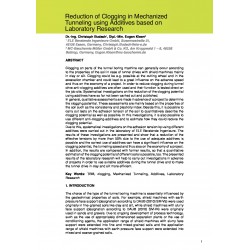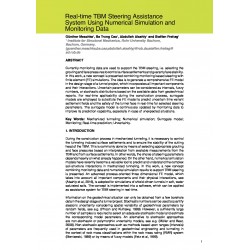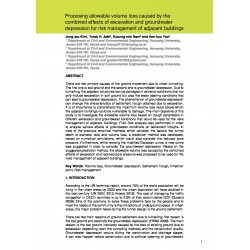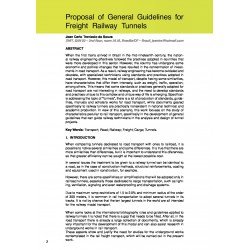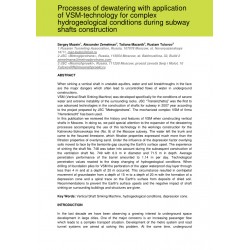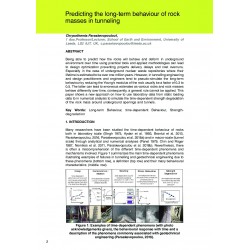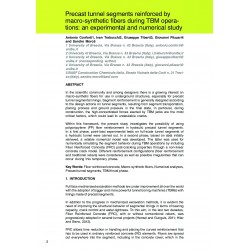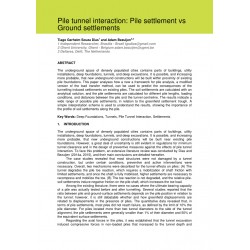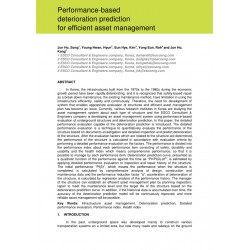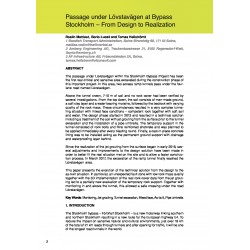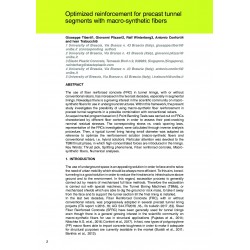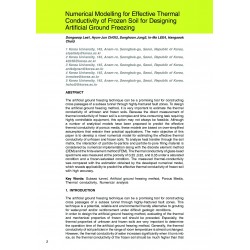No document
Search & filter
Search for a publication
Search & filter
World Tunnelling Congress
WTCThere are 1984 documents.
-
Reduction of Clogging in Mechanized Tunneling using Additives based on Laboratory Research
Abstract: Clogging on parts of the tunnel boring machine can generally occur according to the properties of the soil in case of tunnel drives with shield machines mainly in clay or silt. Clogging could be e.g. possible at the cutting wheel and in the excavation chamber and could lead to a great influence on the advance speed and thus on the economy of a project. In order to reduce clogging during tunnel...
0,00 € -
Real-time TBM Steering Assistance System Using Numerical Simulation and Monitoring Data
Abstract: Currently monitoring data are used to support the TBM steering, i.e. selecting the grouting and face pressures to control surface settlements and guaranty face stability. In this work, a new concept is presented combining monitoring based steering with finite element (FE) simulations. The idea is to generate a comprehensive FE model in the design stage of a tunnel project, which incorporates...
0,00 € -
Proposing allowable volume loss caused by the combined effects of excavation and groundwater depression for risk...
Abstract: There are two primary causes of the ground movement due to urban tunnelling. The first one is lost ground and the second one is groundwater depression. Due to tunnelling, the adjacent structures can be damaged in extreme conditions that not only include excavation in soft ground but also the water bearing conditions that can lead to groundwater depression. The phenomenon of groundwater...
0,00 € -
Proposal of General Guidelines for Freight Railway Tunnels
Abstract: When the first trains arrived in Brazil in the mid-nineteenth century, the national railway engineering effectively followed the practices adopted in countries that were more developed in this sector. However, the country has undergone some economic and political changes that have resulted in the concentration of investments in road transport. As a result, railway engineering has become...
0,00 € -
Processes of dewatering with application of VSM-technology for complex hydrogeological conditions during subway...
Abstract: When sinking a vertical shaft in unstable aquifers, water and soil breakthroughs in the face are the major dangers which often lead to uncontrolled flows of water in underground constructions. VSM (Vertical Shaft Sinking Machine) was developed specifically for the conditions of severe water and extreme instability of the surrounding rocks. JSC “Transinzhstroj” was the first to use advanced...
0,00 € -
Predicting the long-term behaviour of rock masses in tunneling
Abstract: Being able to predict how the rocks will behave and deform in underground environment over time using practical tools and applied methodologies can lead to design optimization preventing projects delivery delays and cost overruns. Especially in the case of underground nuclear waste repositories where their lifetime is estimated to be over one million years. However, in tunnelling engineering...
0,00 € -
Precast tunnel segments reinforced by macro-synthetic fibers during TBM opera tions: an experimental and numerical study
Abstract: In the scientific community and among designers there is a growing interest on macro-synthetic fibers for use in underground structures, especially for precast tunnel segmental linings. Segment reinforcement is generally designed according to the design actions on tunnel segments, resulting from segment transportation, placing process and ground pressure in the final state. In particular,...
0,00 € -
Using Tunnel Boring Machine Penetration Tests to Quantify Performance in Hard Rock
Abstract: Tunnel boring machine (TBM) excavation efficiency in high strength “hard” rocks can be significantly impacted when operating in rocks that are excavated by grinding rather than chipping. Identifying which excavation process is occurring can help TBM operators decide how to operate the machine. This can also help with contract payments where progress is slowed due to poor excavation efficiency....
0,00 € -
Polymer Binder, Impact on the Pull-Out Force of Macro Fibers in Sprayed Concrete
Abstract: Macro-fibers have been used in sprayed concrete for many years now, particularly to prevent cracks from developing in the concrete due to deformation energy. These fibers can be made of steel or plastics and are provided to the customer. The type of fiber to be used is selected based on the building project’s requirements. Usually, the fibers are added to the sprayed concrete in the standard...
0,00 € -
Pile tunnel interaction: Pile settlement vs Ground settlements
Abstract: The underground space of densely populated cities contains parts of buildings, utility installations, deep foundations, tunnels, and deep excavations. It is possible, and increasing more probable, that new underground constructions will be built within proximity of existing pile foundations. This paper analyses how a new a framework for pile analysis, a modified version of the load transfer...
0,00 € -
Performance-based deterioration prediction for efficient asset management
Abstract: In Korea, the infrastructures built from the 1970s to the 1980s during the economic growth period have been rapidly deteriorating, and it is recognized that safety-based repair as a break-down maintenance, the existing maintenance method, have limitation in using the infrastructure efficiently, safety and continuously. Therefore, the need for development of system that enables appropriate...
0,00 € -
Passage under Lövstavägen at Bypass Stockholm – From Design to Realization
Abstract: The passage under Lövstavägen within the Stockholm Bypass Project has been the first real critical and sensitive area excavated during the construction phase of this important project. In this area, two access ramp tunnels pass under the fourlane road named Lövstavägen. Above the tunnel crown, 7-10 m of soil and no rock cover had been verified by several investigations. From the top down, the...
0,00 € -
Optimized reinforcement for precast tunnel segments with macro-synthetic fibers
Abstract: The use of fiber reinforced concrete (FRC) in tunnel linings, with or without conventional rebars, has increased in the two last decades, especially in segmental linings. Nowadays there is a growing interest in the scientific community on macrosynthetic fibers for use in underground structures. Within this framework, the present study investigates the possibility of using macro-synthetic fiber...
0,00 € -
Optimization of Double-Track Tunnel Construction Technological Process for “Nevsko-Vasileostrovskaya – Line 3” of St....
Abstract: During construction of St. Petersburg subway system engineers from design and construction companies, through their joint efforts, perform continuous work of developing and application of modern technologies and mechanisms designed to facilitate work in underground conditions; decreasing costs of metro system construction; accelerate the performance of mining operations. At the same time both...
0,00 € -
Numerical Study of Waterproofing Membrane Considering Contact Behavior
Abstract: An waterproofing membrane has a relatively higher initial strength, faster construction time and higher waterproofing performance than the conventional sprayed concrete linings. Waterproofing membrane mainly consists of polymers and its supporting potential is from the adhesion at the interface and tensile strength which is distinct from the conventional method such as the shotcrete. However,...
0,00 € -
Numerical Modelling for Effective Thermal Conductivity of Frozen Soil for Designing Artificial Ground Freezing
Abstract: The artificial ground freezing technique can be a promising tool for constructing cross passages of a subsea tunnel through highly-fractured fault zones. To design the artificial ground freezing method, it is very important to estimate the thermal conductivity of unfrozen and frozen soils. Because the direct measurement of thermal conductivity of frozen soil is a complex and time-consuming task...
0,00 €

